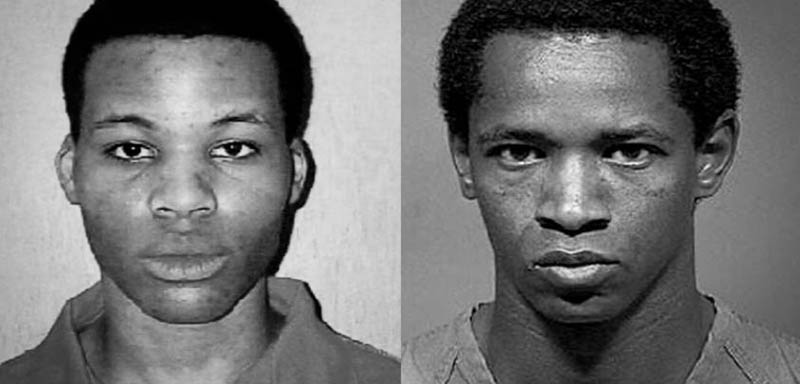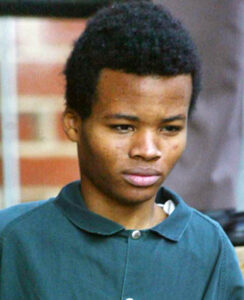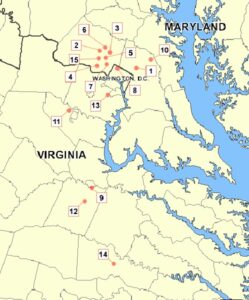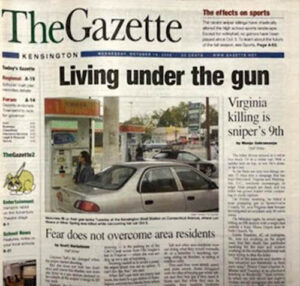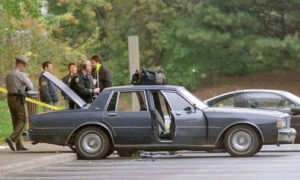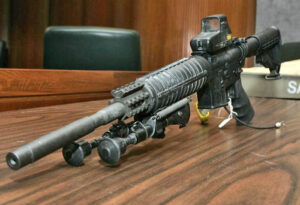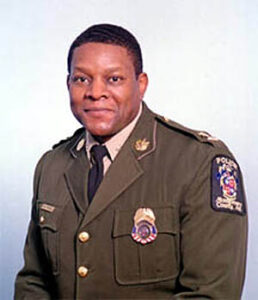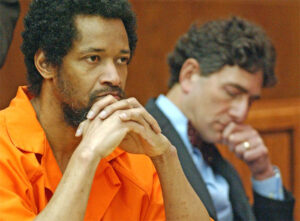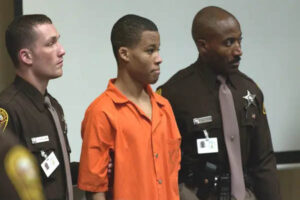The Beltway Sniper attacks, also known as the D.C. sniper attacks, were a series of coordinated shootings that occurred during three weeks in October 2002 throughout the Washington, D.C. metropolitan area, consisting of the District of Columbia, Maryland, and Virginia. Preliminary shootings consisted of murders and robberies in several states that lasted six months, beginning in February 2002. Seven people were killed, and seven others were injured in the preliminary shootings. Ten were killed, and three were critically wounded in the October shootings. In total, the snipers killed 17 people and wounded ten others in a 10-month span.
The snipers were 41-year-old John Allen Muhammad and 17-year-old Lee Boyd Malvo, who traveled in a blue 1990 Chevrolet Caprice sedan.
Preliminary Shootings
On February 16, 2002, 21-year-old cashier Keenya Nicole Cook was shot and killed by Lee Malvo at the front door of her aunt’s home in Tacoma, Washington. Cook’s aunt, Isa Nichols, had been good friends with John Allen Muhammad’s ex-wife Mildred and had encouraged her to seek a divorce.
On March 19, 2002, Jerry Taylor, 60, was killed by a single shot to the chest fired from long range as he practiced chip shots at a Tucson, Arizona, golf course. John Muhammad’s sister lived near the golf course, and he was visiting her at the time of the shooting.
Two deaths and four injuries followed in other states from March through July 2002.
On August 1, 2002, John Gaeta, 51, was changing a tire slashed by Lee Malvo at a parking lot in Hammond, Louisiana. Malvo then shot him in the neck. The bullet exited through Gaeta’s back, and he pretended to be dead while Malvo stole his wallet. Gaeta ran to a service station after Malvo left and discovered that he was bleeding; he went to a hospital and was released within an hour. Years later, on March 1, 2010, Gaeta received a letter of apology from Malvo.
On September 5, 2002, at 10:30 p.m., Paul LaRuffa, a 55-year-old pizzeria owner, was shot six times at close range while locking up his Italian restaurant in Clinton, Maryland. LaRuffa survived the shooting, and his laptop computer was found in John Muhammad’s car when he and Malvo were arrested.
On September 14, 2002, 22-year-old Rupinder “Benny” Oberoi, an employee of the Hillandale Beer & Wine liquor store in Silver Spring, Maryland, was shot in the back outside the store. Oberoi survived the shooting. The shooting was officially linked to Muhammad and Malvo by the Montgomery County Police Department.
Muhammad Rashid was shot on September 15, 2002, while closing Three Roads Liquors in Brandywine, Maryland. Rashid later identified Malvo as the shooter in court.
On September 21, 2002, at 12:15 a.m., 41-year-old Million A. Waldemariam was fatally shot in the head and back with a .22-caliber pistol in Atlanta, Georgia. Waldemariam was helping the Sammy’s Package Store owner close up for the night when the shooting occurred.
Nineteen hours later, on the same day, Claudine Parker, a 52-year-old liquor store clerk in Montgomery, Alabama, was shot in the chest and killed during a robbery. Her coworker, 24-year-old Kellie Adams, was critically wounded by a shot through the neck but survived. Evidence at the crime scene eventually tied this killing to the Beltway attacks, allowing authorities to identify Muhammad and Malvo as suspects. However, this connection was not made until October 17, almost four weeks later.
On September 23, 2002, at 6:30 p.m., 45-year-old Hong Im Ballenger was shot in the head and killed with a Bushmaster rifle in Baton Rouge, Louisiana. Muhammad and Malvo were later linked to the killing.
Baltimore, Montgomery County, Maryland, & Washington DC Area Attacks
At 5:20 p.m. on Wednesday, October 2, 2002, a shot was fired through the window of a Michaels craft store in Aspen Hill, Maryland. The bullet narrowly missed Ann Chapman, a cashier at the store. Since no one was injured, the shot was assumed to be random, and no serious alarms were raised. However, approximately one hour later, at 6:30 p.m., James Martin, a 55-year-old program analyst at NOAA, was shot and killed at 2201 Randolph Road in the Wheaton Shoppers Food Warehouse grocery store parking lot.
On the morning of October 3, four people were shot and killed within approximately two hours in Aspen Hill and other nearby areas in Montgomery County, Maryland. Another was killed that evening in the Takoma neighborhood of the District of Columbia.
At 7:41 a.m., James L. Buchanan, a 39-year-old landscaper known as “Sonny”, was shot dead at 11411 Rockville Pike, near Rockville, Maryland. Buchanan was shot while mowing the grass at the Fitzgerald Auto Malls.
At 8:12 a.m., a 54-year-old part-time taxi driver, Prem Kumar Walekar, was killed in Aspen Hill in Montgomery County while pumping gasoline into his taxi at a Mobil station at Aspen Hill Road and Connecticut Avenue.
At 8:37 a.m., Sarah Ramos, a 34-year-old babysitter and housekeeper, was killed on 3701 Rossmoor Boulevard at the Leisure World Shopping Center in Norbeck. She had gotten off a bus and was seated on a bench reading a book at the time of her murder.
At 9:58 a.m., 25-year-old Lori Ann Lewis-Rivera was killed while vacuuming her Plymouth Grand Voyager at the Shell station at the intersection of Connecticut and Knowles Avenues in Kensington, Maryland.
The snipers waited until 9:20 p.m. before shooting Pascal Charlot, a 72-year-old retired carpenter, while walking on Georgia Avenue at Kalmia Road in Washington, D.C. Charlot died less than an hour later.
In each shooting, the victims were killed by a single bullet fired from some distance, and, in each case, the killers struck and vanished. This pattern was not detected until after the October 3 shootings occurred.
Fear quickly spread throughout the region as news of the shootings spread. At a press conference, the Chief of Police for Montgomery County, Charles Moose, informed parents that schools were on a code blue alert, keeping children indoors to keep the schools safe. Many parents picked up their children early, not allowing them to take a school bus or walk home. Montgomery County Public Schools, District of Columbia Public Schools, and private schools were locked down, with no recess or outdoor physical education classes. Other school districts in the area also took precautionary measures, keeping students indoors. During the shootings, law enforcement agencies from neighboring states became embedded in the investigation through telephone tips.
Police had only a few pieces of evidence to work with. One initial report said that right after the Silver Spring attack, someone had reportedly heard a popping noise and had seen a white box truck hurriedly leaving the scene. After the murder in Washington, D.C., witnesses began telling police they had seen a blue Chevrolet Caprice rather than a white box truck. The police initially believed all the murders were carried out with a .223 caliber rifle.
At this point, Malvo and Muhammad started covering a wider area and taking two or three days between shootings.
On October 4, at 2:30 p.m., 43-year-old homemaker Caroline Seawell was wounded in the chest while loading sacks into her minivan in the parking lot of another Michaels store, this time in Spotsylvania, Virginia. Hundreds of journalists had converged to cover the unfolding events by this point. School officials reassured the public that they were taking every measure possible to protect children by tightening security and canceling all outdoor activities. But when the work and school week resumed three days later, so did the shootings.
On October 7, at 8:09 a.m., Iran Brown, a 13-year-old student, was shot in the chest and critically wounded as he arrived at Benjamin Tasker Middle School on 4901 Collington Road in Bowie, Maryland, in Prince George’s County. His aunt, Tanya Brown, was a nurse who had just brought him to school, and she rushed him to a hospital emergency room. Despite sustaining severe injuries, including damage to several major organs, Brown survived the attack and ultimately testified at Muhammad’s trial.
At this crime scene, the authorities discovered a shell casing and a Tarot Death card inscribed with the phrase “Call me God” on the front and three separate lines on the back: “For you, Mr. Police.” “Code: ‘Call me God’.” “Do not release to the press.” Despite police efforts to honor the request not to release information about the card to the press, details were made public by WUSA-TV and then by The Washington Post just one day later.
On October 9 at 8:18 p.m., 53-year-old civil engineer Dean Harold Meyers was shot dead while pumping gasoline at a Sunoco gas station on 7203 Sudley Road in Prince William County, Virginia, near Manassas.
On the morning of October 11 at 9:30 a.m., 53-year-old businessman Kenneth Bridges was shot and killed while pumping fuel at an Exxon station off Interstate 95 in Spotsylvania County, Virginia, near Fredericksburg.
On October 14, at 9:15 p.m., 47-year-old Linda Franklin, an FBI intelligence analyst who was a resident of Arlington County, Virginia, was shot dead in a covered parking lot at Home Depot in Fairfax County, Virginia, just outside Falls Church at Seven Corners Shopping Center.
During the weeks when the attacks occurred, public fear mounted of the random shootings, especially concerning sites such as service stations and parking lots of large stores, where many had taken place. No one felt safe being outdoors in public. Gas stations had begun to put tarps up to conceal their customers. Some people crouched over to pump gas while others waited in their cars.
Also, many people with access tried to fuel their vehicles at the naval base of the National Naval Medical Center in Bethesda, Maryland, as they felt it was safer inside the guarded fence. Government buildings such as the White House, the U.S. Capitol, the Supreme Court building, and memorial tourist attractions at the National Mall in Washington, D.C., also received heightened security. For the duration of the attacks, United States Senate pages received a driven police escort to and from the United States Capitol every day. They were prohibited from leaving their residence hall for any reason except work. Other motorists viewed drivers of white vans and box trucks with suspicion as initial media reports indicated the suspect might be driving such a vehicle.
With seven separate shooting victims, including six deaths, in the first 15 hours of the D.C. area spree, the North American media soon devoted extensive coverage. By the middle of October 2002, all news television networks provided live coverage of each attack’s aftermath, which often lasted for hours. The Fox show America’s Most Wanted devoted an entire episode to the shooters in hopes of aiding their capture.
Ironically, the big break in the case came from the snipers themselves. On October 17, a caller claiming to be the sniper phoned in to say, in a bit of an investigative tease, that he was responsible for the murder of two women during the robbery of a liquor store in Montgomery, Alabama, a month earlier. The call was traced to a pay telephone at a gasoline station in Henrico County, Virginia. Police missed the suspects by a matter of a few minutes and initially detained occupants of a van at another pay telephone at the same intersection.
Investigators soon learned that a crime similar to the one described in the call had indeed taken place — and that fingerprint and ballistic evidence were available from the case. An agent from the Mobile, Alabama office gathered the evidence and quickly flew to Washington, D.C., arriving Monday evening, October 21. While the Bureau of Alcohol, Tobacco, Firearms and Explosives (ATF) handled the ballistic evidence, the FBI took the fingerprint evidence to their Lab. The following morning, the fingerprint database produced a match — a magazine dropped at the crime scene bore the fingerprints of Lee Boyd Malvo from a previous arrest in Washington State. They now had a suspect.
The arrest record provided another significant lead, mentioning John Allen Muhammad. One FBI agent from Tacoma, Washington, recognized the name from a tip called into that office on the case. Now, there was a second suspect.
The FBI’s work with ATF agents revealed that Muhammad had a Bushmaster .223 rifle in his possession, a federal violation since he had been served with a restraining order to stay away from his ex-wife. That enabled the agents to charge him with federal weapons violations. With Malvo clearly connected, the FBI and ATF jointly obtained a federal material witness warrant for him. Now, they just had to catch them.
In the meantime, Malvo and Muhammad were silent for five days before striking again. On October 19 at 8:00 p.m., 37-year-old Jeffrey Hopper was shot in a parking lot near the Ponderosa Steakhouse at State Route 54 in Ashland, Virginia, near Interstate 95. His wife Stephanie called out to passersby, who phoned for an ambulance, enabling Hopper to survive his injuries. Authorities discovered a four-page letter from the shooter in the woods that demanded $10 million and made a threat to children.
On October 22, Ride On bus driver Conrad Johnson, 35, was shot at 5:56 a.m. while standing on the steps at the 14100 block of Grand Pre Road in Aspen Hill, Maryland. Johnson died of his injuries. On the same day, Chief Moose released part of the content of one of the shooter’s letters, declaring, “Your children are not safe, anywhere, at any time.”
The same day, the FBI searched their criminal records database and found that Muhammad had registered a blue Chevy Caprice with the license plate of NDA-21Z in New Jersey. That description was given to the news media and shared far and wide.
While no shootings occurred on October 23, the day was significant for two events. First, ballistics experts confirmed Johnson as the 10th fatality in the Beltway shootings. Second, in a yard in Takoma Park, Maryland, police searched with metal detectors for bullets, shell casings, or other evidence that might provide a link to the shooters. A tree stump believed to have been used for target practice was seized.
The case was led by the Montgomery County, Maryland Police Department, headed by Chief Charles Moose, with the FBI and many other law enforcement agencies playing a supporting role. Chief Moose had specifically requested the FBI’s help through a federal law on serial killings.
Within days, the FBI had some 400 agents nationwide working on the case. They had set up a toll-free number to collect tips from the public, with teams of new agents in training helping to work the hotline. Evidence experts were asked to map many of the evolving crime scenes digitally, and behavioral analysts helped prepare a profile of the shooter for investigators. They also set up a Joint Operations Center to help Montgomery County investigators run the case.
At approximately 11:45 p.m. on October 23, the snipers’ dark blue 1990 Chevy Caprice with its New Jersey license plate had been spotted at a rest stop parking lot off I-70 in Maryland. Within the hour, law enforcement swarmed the scene, setting up a perimeter to check out any movements and ensure there’d be no escape.
On the morning of October 24, the hunt for the snipers quickly came to an end when a team of Maryland State Police, Montgomery County SWAT officers, and special agents from the FBI’s Hostage Rescue Team arrested the sleeping John Allen Muhammad and Lee Boyd Malvo without struggle.
Police were tipped off by two 911 calls from individuals at the rest stop. Four hours earlier, Montgomery County police chief Charles Moose relayed this cryptic message to the sniper: “You have indicated that you want us to do and say certain things. You have asked us to say, ‘We have caught the sniper like a duck in a noose.’ We understand that hearing us say this is important to you”. Moose asked the media “to carry the message accurately and often.” This statement may refer to a Cherokee fable.
What evidence experts from the FBI and other police forces found there was both revealing and shocking. The car had a hole cut in the trunk near the license plate, so shots could be fired from within the vehicle. It was, in effect, a rolling sniper’s nest. A stolen Bushmaster .223-caliber weapon and bipod were found in a bag in Muhammad’s car. Ballistics tests later conclusively linked the seized rifle to 11 of the 14 shootings, including one in which no one was hurt. Also found in the car was a digital voice recorder used by Malvo and Muhammad to make extortion demands, a laptop stolen from one of the victims containing maps of the shooting sites and getaway routes from some of the crime scenes, other maps, and walkie-talkies.
During pre-trial motions, investigators and the prosecution suggested that Muhammad intended to kill his second ex-wife, Mildred, who he felt had estranged him from his children. According to this hypothesis, the other shootings were intended to cover up the motive for the crime. Muhammad believed that the police would not focus on an estranged ex-husband as a suspect if Mildred appeared to be a random victim of a serial killer. During the attacks, Muhammad frequented the neighborhood where she lived, and some incidents occurred nearby. Additionally, he had earlier made threats against her. Mildred herself said she was his intended target, claiming that when the police first approached her, one officer said, “Ms. Muhammad, didn’t you know you were the target?” However, Judge LeRoy F. Millette Jr. prevented prosecutors from presenting that theory during the trial, saying that a link had not been firmly established.
Change of venue requests by defense attorneys were granted, and the first trials were held in the independent cities of Chesapeake and Virginia Beach in southeastern Virginia, more than 100 miles from the closest alleged attack. During their trials in the fall of 2003, involving two of the victims in Virginia, Muhammad and Malvo were each found guilty of murder and weapons charges. The jury in Muhammad’s case recommended that he be sentenced to death, while Malvo’s jury recommended a sentence of life in prison without parole instead of the death penalty. The judges concurred in both cases.
The Virginia Supreme Court affirmed Muhammad’s death penalty on April 22, 2005, when it ruled that he could be sentenced to death because the murder was part of an act of terrorism. This reasoning was based on the handwritten note demanding $10 million. The court rejected an argument by defense lawyers that Muhammad could not be sentenced to death because he was not the triggerman in the killings.
On September 16, 2009, circuit court judge Mary Grace O’Brien set an execution date of Muhammad for November. His attorneys petitioned the U.S. Supreme Court to stay his execution, but it was denied. They also requested clemency from Virginia Governor Tim Kaine, which was also denied.
Muhammad was executed by lethal injection at the Greensville Correctional Center in Jarratt, Virginia, on November 10, 2009. The execution began at 9:06 p.m. EST; Muhammad died five minutes later.
Malvo pleaded guilty to six murders and confessed to others in other states while being interviewed in Maryland and testifying against Muhammad. Malvo was sentenced to six consecutive life terms without the possibility of parole.
In 2017, the United States Court of Appeals for the Fourth Circuit vacated Malvo’s three life sentences in Virginia on appeal, with re-sentencing ordered due to the fact that mandatory life sentences for juvenile criminals without the possibility of parole violate the Eighth Amendment to the U.S. Constitution.
On February 25, 2020, a Virginia law was passed allowing those serving life sentences for offenses committed before the age of 18 to seek release after serving 20 years. However, the U.S. Supreme Court case was dismissed at the request of lawyers on both sides. Ultimately, Malvo was sentenced to ten consecutive life sentences without the possibility of parole and later commuted to life with parole.
© Kathy Alexander/Legends of America, updated March 2024.
Also See:
Sources:

